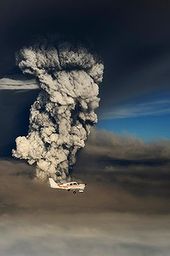
The plume of ash from Grimsvotn, located in the southeast of Iceland at the heart of its largest glacier, Vatnajoekull, had fallen to two kilometers on Tuesday evening, according to an Icelandic crisis management official.
The column "is decreasing now and the height of the plume is around two kilometers so it's dramatically decreased," Thorir Hrafnsson, a spokesman for Iceland's crisis management agency, told AFP.
"If it behaves like earlier eruptions, hopefully it will be over by the weekend," he said, while stressing "it's very hard to guess."
At an altitude of just two kilometres, the plume "will not be dangerous for air traffic," Hrafnsson said, acknowledging that ash still in the air from the initial blast could continue to cause problems.
"The only danger now is old ash that is up in the air," he said, adding it was "very unlikely (the plume) will increase again."
"There is less activity. ... A lot less of the ash is going into the atmosphere," Petur Matthiasson, a spokesman for Iceland's Civil Protection and Emergency Management Administration said.
"This is good news for aviation at least," Mattiasson said, noting that while "there is still a lot of ash fall in the vicinity of the volcano in the south of Iceland," the lower column of ash meant "there is a lot less going into the atmosphere and going into the jet stream".
On Tuesday, airlines grounded about 500 flights after ash from Grimsvotn swept over Britain and towards northern Europe.
However, experts said they did not expect to see the same level of air travel disruption as last year, when a cloud of ash from the nearby Eyjafjoell volcano grounded more than 100,000 flights and left eight million passengers stranded.
With its greatly diminished plume of ash, the volcano itself does not for the time being pose a great threat to aviation, Elin Jonasdottir, a meteorologist at the Icelandic Meteorological Office, told AFP.
"The lower the plume the less threat there is to aviation," she said, noting however that the initial burst "did go up to 20 kilometers, which is very, very high, and that is what is going around now."
"The winds over the volcano are mostly northerly, so the ash is blown south, and far south of Iceland there are jet winds going from west to east, so the ash is blown to Britain and on to Europe and Scandinavia," she said.
Another problem, according to Jonasdottir, was that the winds were shifting a greater concentration of the ash into Icelandic skies and west towards the capital, meaning the country's main airport Keflavik might need to close again.
The airport and most of Iceland's airspace was closed on Sunday, but reopened on Monday evening.
Hjordis Gudmundsdottir, a spokeswoman for Iceland's airport authority, Isavia, told AFP: "It can be that we will close again, but we think it will be open tomorrow... It's just old ash, we're waiting for the old ash to disappear."
Grimsvoetn is Iceland's most active volcano, erupting nine times between 1922 and 2004, but its eruptions have usually been quite short.
Baldursdottir however noted that the same volcano had erupted for seven months in 1873, but stressed that for most of that period it was a "low-intensity" eruption.
The ongoing eruption has meanwhile shown the most violent start ever registered at Grimsvoetn, and the peak of its plume towered at around twice the height of the column spewed out last year by Eyjafjoell.



Reader Comments
to our Newsletter